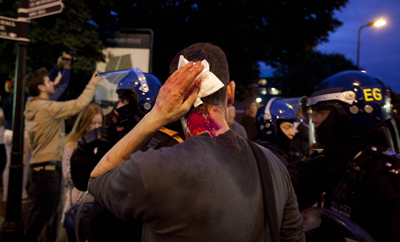The safety advisories sent out by the International News Safety Institute on Tuesday said it all: “Bring a mobile phone with emergency numbers pre-set for speed dialling; bring eye protection such as swimming goggles; carry first-aid kits and know how to use them; wear loose, natural-fabric clothing as it will not burn as readily as synthetics; and remember there is always the possibility of gasoline bombs being detonated.”
Since urban riots started in several British cities on Saturday night, journalists have literally been under fire. Civil disturbances always carry the risk of getting in harm’s way for reporters–they can find themselves being trapped between police and demonstrators; they can be hit by missiles, bludgeoned by security forces, suffocated by tear gas, or drowned by water cannons. These are all risks that come with the job.
However, in this week’s riots, British journalists have been the direct targets of violence, leading professional organizations such as the National Union of Journalists to send warning messages and provide safety advice and guidance. CPJ has also firmly condemned these attacks in a statement. “News organizations must take precautions, said CPJ executive director Joel Simon, but we hope demonstrators recognize that it is in the public interest for journalists, as independent observers, to witness and report the facts.”
The list of incidents highlights a pattern of attacks against the media. Mark Stone, a Sky News reporter, just back from an assignment in Libya, was chased by rioters and forced to flee during disturbances near Clapham Junction in London on Monday. BBC and Sky News reporters had to retreat when their vehicles had their windows smashed by rioters in Croydon the same day. CNN’s Dan Rivers had to take protection behind police lines in Peckham when bottles started to rain down around him.
As is usually the case in street riots, photojournalists have been bearing the brunt of violence against the media. “If your pictures are not good enough, you are not close enough,” photojournalist Robert Capa famously said. Photographers are the most visible and their equipment provides an easy and iconic target for robbers or vandals. Several of them have been kicked and beaten and have had their equipment smashed by gangs of lawless youth.
Journalists at major news organizations have received advisories on how to confront the threats of violence. According to The Guardian, “the BBC and Sky News are understood to have hired private security guards to accompany their cameramen, after they attracted hostility on Saturday.” Some photojournalists also try to remain as inconspicuous as possible “by using high-definition flip cameras that look like mobile phones but take professional quality images,” The Guardian said.
These attacks against journalists in Britain reflect a wider European pattern of hostility toward the media in the course of civil disturbances. During the 2005 riots in the French banlieues, journalists in general and television reporters in particular were also targeted by rioters and looters. Journalists are often accused of being “part of the system” and in cahoots with the Establishment. Although the London media, depending on their liberal or conservative editorial line, disagree on the causes of the riots “all national newspapers,” writes Guardian columnist Roy Greenslade, “agree on one thing: it [looting and pillaging] must be stopped and the police efforts to restore order must be supported.”
Some suspect the media may be giving over incriminating evidence to the police. In the U.K., under the Police and Criminal Evidence Act 1984, the police can obtain an order from a judge forcing the media to provide unpublished material. “Sadly,” writes media law consultant David Banks, “the courts have not often been sympathetic to media arguments that handing over material prevents them from doing their jobs. This leaves journalists caught in the middle between the police, who regard them as a hindrance, and rioters, who regard them as evidence-gatherers.”
